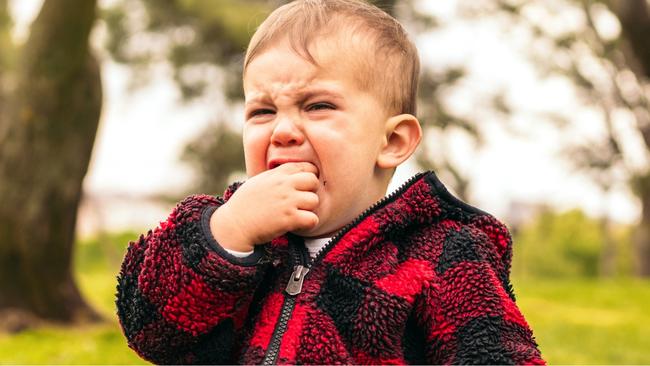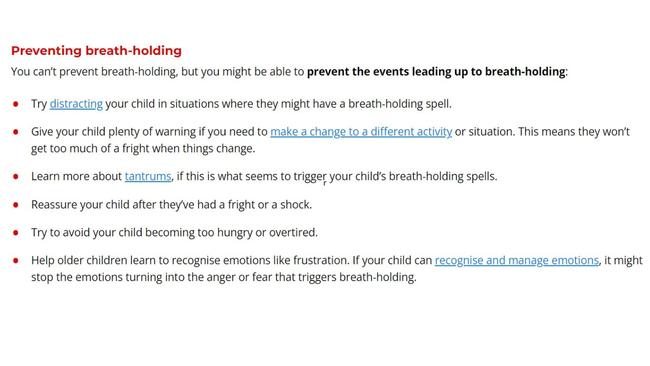The terrifying thing my toddler does during a tantrum
"During each one, I can almost hear the gray hairs springing out of head."
Parenting
Don't miss out on the headlines from Parenting. Followed categories will be added to My News.
A mum has shared a surprisingly common, but totally horrifying, thing her son does when he has a tantrum: he holds his breath.
Sophie Brickman shared her story, explaining that the first time her son held his breath on purpose was on a plane when he was 18 months old.
As a result, he passed out.
Want to join the family? Sign up to our Kidspot newsletter for more stories like this.
RELATED: ‘Your kid’s tantrum is not my problem’
"Head lolling forward, skin blueish-gray"
In an article called My Son Is A ‘Breathholder’ & It’s Terrifying, the mum of three writes that the experience was the first of many, until very recently, when she discovered a potential solution for her own peace of mind.
Of the tantrum on the plane, she adds that after he fainted from the breath holding:
"[I watched] my son, head lolling forward, skin a blueish-gray.
"It couldn’t have been more than a few seconds until he opened his eyes again, woozy and sweaty, and started regaining his normal pinkish perfection before curling up in my lap quietly, clearly just exhausted since he’d skipped his nap."
When Brickman sought medical advice afterwards, she was surprised at the 'casual' responses she received.
"Some kids just hold their breath, and fainting is a way for them to reset," one told her, adding, "Make sure he’s in a position where he can’t hit his head — lie him down if possible.
"And please remember: you can’t be beholden to a toddler who is going to threaten to faint every time you don’t give him what he wants. That’s just madness."
Another doctor matched that advice, telling the mum, "Some kids simply held their breath if they got pissed off."

RELATED: ‘Gentle parenting doesn’t work’
"Two types of breath holding"
Brickman became super-vigilant of her son's impending tantrum signals, which was exhausting - so she persisted with her research.
"Up to 5% of healthy children, I learned, experience these spells, which are not choices but reflexes, a child’s automatic response to distress or frustration," she writes.
"Most kids outgrow the spells by age four, almost all by age six.
"There are two types. My son (who just turned three) experiences what is known as cyanotic breath-holding, which occurs when a child is crying so hard he can’t draw breath — mouth open in a scream, no noise coming out — which leads to fainting.
"The other, pallid breath-holding, is often triggered by a sudden pain or fright, which causes the child to turn gray, get sweaty, then lose consciousness."
The mum reports that she tried distraction techniques such as a wet flannel, or blowing, on the face, but they didn't always work.
"Of the countless times he’s started to cry since that airplane ride, he’s fainted five times in two years. Just five times, total, triggered by getting either frustrated (give me the lollipop already!) or mildly hurt and surprised (like when he ran off the edge of a couch because, what is depth perception?).
"During each one, I could almost hear the gray hairs springing out of my hairline."
"And then he took a breath"
Brickman reports that her son's last episode was more than six months ago. She finally learned that sometimes, she just had to 'wait it out'.
"I stood there, watching him turn blue, my heart starting to race — and then he took a breath. And we went on with our day."
What else can parents do when their child has these "terrifying", as Brickman describes them, episodes?
The Australian government's official children's health website, The Raising Children Network, says:
- Children might hold their breath when they’re upset or hurt. They don’t do it on purpose.
- Stay calm during a breath-holding spell. Don’t try to make your child breathe.
- Breath-holding spells usually end within a minute.
- See a doctor to make sure breath-holding isn’t a sign of something more serious.
The site also explains some reasons for breath-holding, and educates parents on their options.
Importantly, it advises:
"Some cases of breath-holding are associated with iron deficiency anaemia. Your GP can do a simple blood test to work out whether this is the cause in your child’s case."

Dr Sam Hay explains breath-holding
Regular Kidspot medical contributor, Dr Sam Hay, also has this to say about breath-holding:
"Kids experience a breath holding ‘spell’ when they suddenly hold their breath way longer than you expect, closely followed by some pretty scary events. Kids might turn blue, pass out, or even have a seizure. These are unbelievably distressing moments for any parent.
"Thankfully no harm is done during these spells, and kids eventually grow out of them.
"Breath holding spells are actually ridiculously common, affecting up to one in twenty kids. Kids usually have their first by eighteen months, but can experience them as young as six months. Thankfully, the greatest majority grow out of them by the time they turn six.
"Although it’s gut wrenching to watch your child go through episodes like these, there’s really no need to panic. No treatment is needed at the time - there’s no need to throw a glass of water over them, or fan them down with the newspaper.
"Simply roll them on their side, keep them safe and protected from any object that could hurt them, and your child will very quickly start breathing on their own."
For more advice on breath-holding from Dr Hay, see here.
For more information on breath-holding, see the Raising Children Network, and speak to a children's medical health professional.
More Coverage
Originally published as The terrifying thing my toddler does during a tantrum





